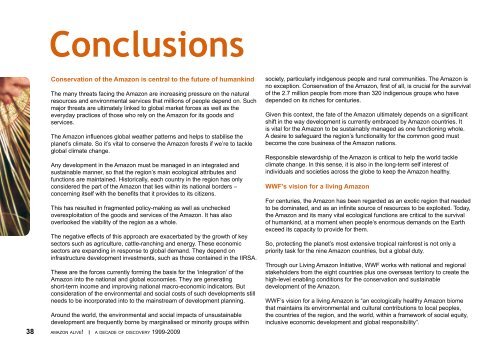Amazon Alive: A Decade of Discoveries 1999-2009 - WWF
Amazon Alive: A Decade of Discoveries 1999-2009 - WWF
Amazon Alive: A Decade of Discoveries 1999-2009 - WWF
Create successful ePaper yourself
Turn your PDF publications into a flip-book with our unique Google optimized e-Paper software.
Conclusions<br />
Conservation <strong>of</strong> the <strong>Amazon</strong> is central to the future <strong>of</strong> humankind<br />
The many threats facing the <strong>Amazon</strong> are increasing pressure on the natural<br />
resources and environmental services that millions <strong>of</strong> people depend on. Such<br />
major threats are ultimately linked to global market forces as well as the<br />
everyday practices <strong>of</strong> those who rely on the <strong>Amazon</strong> for its goods and<br />
services.<br />
The <strong>Amazon</strong> influences global weather patterns and helps to stabilise the<br />
planet’s climate. So it’s vital to conserve the <strong>Amazon</strong> forests if we’re to tackle<br />
global climate change.<br />
Any development in the <strong>Amazon</strong> must be managed in an integrated and<br />
sustainable manner, so that the region’s main ecological attributes and<br />
functions are maintained. Historically, each country in the region has only<br />
considered the part <strong>of</strong> the <strong>Amazon</strong> that lies within its national borders –<br />
concerning itself with the benefits that it provides to its citizens.<br />
This has resulted in fragmented policy-making as well as unchecked<br />
overexploitation <strong>of</strong> the goods and services <strong>of</strong> the <strong>Amazon</strong>. It has also<br />
overlooked the viability <strong>of</strong> the region as a whole.<br />
The negative effects <strong>of</strong> this approach are exacerbated by the growth <strong>of</strong> key<br />
sectors such as agriculture, cattle-ranching and energy. These economic<br />
sectors are expanding in response to global demand. They depend on<br />
infrastructure development investments, such as those contained in the IIRSA.<br />
These are the forces currently forming the basis for the ‘integration’ <strong>of</strong> the<br />
<strong>Amazon</strong> into the national and global economies. They are generating<br />
short-term income and improving national macro-economic indicators. But<br />
consideration <strong>of</strong> the environmental and social costs <strong>of</strong> such developments still<br />
needs to be incorporated into to the mainstream <strong>of</strong> development planning.<br />
Around the world, the environmental and social impacts <strong>of</strong> unsustainable<br />
development are frequently borne by marginalised or minority groups within<br />
society, particularly indigenous people and rural communities. The <strong>Amazon</strong> is<br />
no exception. Conservation <strong>of</strong> the <strong>Amazon</strong>, first <strong>of</strong> all, is crucial for the survival<br />
<strong>of</strong> the 2.7 million people from more than 320 indigenous groups who have<br />
depended on its riches for centuries.<br />
Given this context, the fate <strong>of</strong> the <strong>Amazon</strong> ultimately depends on a significant<br />
shift in the way development is currently embraced by <strong>Amazon</strong> countries. It<br />
is vital for the <strong>Amazon</strong> to be sustainably managed as one functioning whole.<br />
A desire to safeguard the region’s functionality for the common good must<br />
become the core business <strong>of</strong> the <strong>Amazon</strong> nations.<br />
Responsible stewardship <strong>of</strong> the <strong>Amazon</strong> is critical to help the world tackle<br />
climate change. In this sense, it is also in the long-term self interest <strong>of</strong><br />
individuals and societies across the globe to keep the <strong>Amazon</strong> healthy.<br />
<strong>WWF</strong>’s vision for a living <strong>Amazon</strong><br />
For centuries, the <strong>Amazon</strong> has been regarded as an exotic region that needed<br />
to be dominated, and as an infinite source <strong>of</strong> resources to be exploited. Today,<br />
the <strong>Amazon</strong> and its many vital ecological functions are critical to the survival<br />
<strong>of</strong> humankind, at a moment when people’s enormous demands on the Earth<br />
exceed its capacity to provide for them.<br />
So, protecting the planet’s most extensive tropical rainforest is not only a<br />
priority task for the nine <strong>Amazon</strong> countries, but a global duty.<br />
Through our Living <strong>Amazon</strong> Initiative, <strong>WWF</strong> works with national and regional<br />
stakeholders from the eight countries plus one overseas territory to create the<br />
high-level enabling conditions for the conservation and sustainable<br />
development <strong>of</strong> the <strong>Amazon</strong>.<br />
<strong>WWF</strong>’s vision for a living <strong>Amazon</strong> is “an ecologically healthy <strong>Amazon</strong> biome<br />
that maintains its environmental and cultural contributions to local peoples,<br />
the countries <strong>of</strong> the region, and the world, within a framework <strong>of</strong> social equity,<br />
inclusive economic development and global responsibility”.<br />
38 amazon alive! I a decade <strong>of</strong> discovery <strong>1999</strong>-<strong>2009</strong>

















